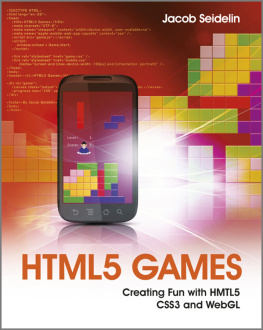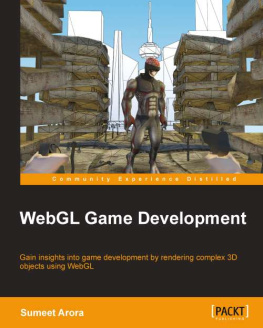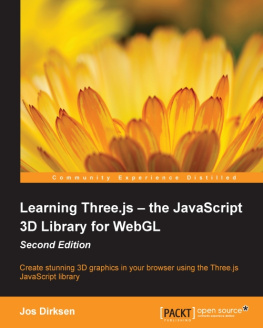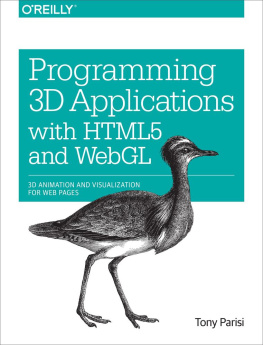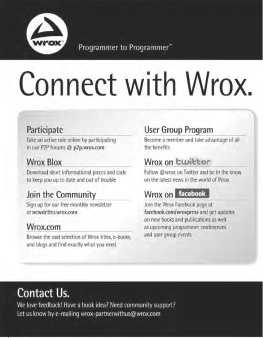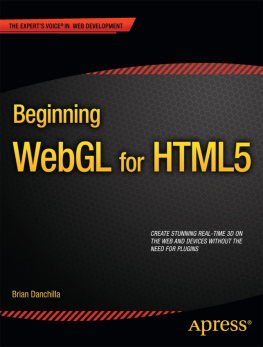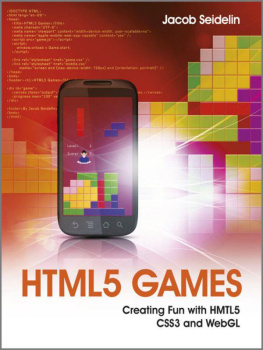Diego Cantor - WebGL Beginners Guide
Here you can read online Diego Cantor - WebGL Beginners Guide full text of the book (entire story) in english for free. Download pdf and epub, get meaning, cover and reviews about this ebook. year: 2012, publisher: Packt Publishing, genre: Computer. Description of the work, (preface) as well as reviews are available. Best literature library LitArk.com created for fans of good reading and offers a wide selection of genres:
Romance novel
Science fiction
Adventure
Detective
Science
History
Home and family
Prose
Art
Politics
Computer
Non-fiction
Religion
Business
Children
Humor
Choose a favorite category and find really read worthwhile books. Enjoy immersion in the world of imagination, feel the emotions of the characters or learn something new for yourself, make an fascinating discovery.
- Book:WebGL Beginners Guide
- Author:
- Publisher:Packt Publishing
- Genre:
- Year:2012
- Rating:5 / 5
- Favourites:Add to favourites
- Your mark:
WebGL Beginners Guide: summary, description and annotation
We offer to read an annotation, description, summary or preface (depends on what the author of the book "WebGL Beginners Guide" wrote himself). If you haven't found the necessary information about the book — write in the comments, we will try to find it.
Become a master of 3D web programming in WebGL and JavaScript
- Dive headfirst into 3D web application development using WebGL and JavaScript.
- Each chapter is loaded with code examples and exercises that allow the reader to quickly learn the various concepts associated with 3D web development
- The only software that the reader needs to run the examples is an HTML5 enabled modern web browser. No additional tools needed.
- A practical beginners guide with a fast paced but friendly and engaging approach towards 3D web development
In Detail
WebGL is a new web technology that brings hardware-accelerated 3D graphics to the browser without installing additional software. As WebGL is based on OpenGL and brings in a new concept of 3D graphics programming to web development, it may seem unfamiliar to even experienced Web developers.
Packed with many examples, this book shows how WebGL can be easy to learn despite its unfriendly appearance. Each chapter addresses one of the important aspects of 3D graphics programming and presents different alternatives for its implementation. The topics are always associated with exercises that will allow the reader to put the concepts to the test in an immediate manner.
WebGL Beginners Guide presents a clear road map to learning WebGL. Each chapter starts with a summary of the learning goals for the chapter, followed by a detailed description of each topic. The book offers example-rich, up-to-date introductions to a wide range of essential WebGL topics, including drawing, color, texture, transformations, framebuffers, light, surfaces, geometry, and more. With each chapter, you will level up your 3D graphics programming skills. This book will become your trustworthy companion filled with the information required to develop cool-looking 3D web applications with WebGL and JavaScript.
What you will learn from this book
- Understand the structure of a WebGL application
- Build and render 3D objects with WebGL
- Load complex models using JSON and AJAX
- Set up a lighting model using shaders, physics of light reflection, and lighting strategies
- Create a camera and use it to move around a 3D scene
- Use texturing, lighting and shading techniques to add greater realism to 3D scenes
- Implement selection of objects in a 3D scene with the mouse
- Advanced techniques to create more visually complex and compelling scenes
Approach
This book is a step-by-step tutorial that includes complete source code for all of the examples covered. Every chapter builds on top of the previous one thereby giving the reader an immediate feeling of progression. Each block of code is explained, and 3D web development concepts are diagrammed and covered in detail.
Who this book is written for
This book is written for JavaScript developers who are interested in 3D web development. A basic understanding of the DOM object model and the jQuery library is ideal but not required. No prior WebGL knowledge is expected.
Diego Cantor: author's other books
Who wrote WebGL Beginners Guide? Find out the surname, the name of the author of the book and a list of all author's works by series.



